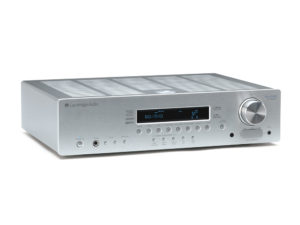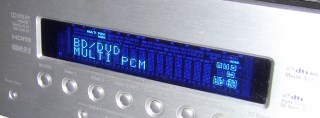AV Equipment, Reviews
Cambridge Audio Azur 551R Review

If you are building your dream games room, chances are you’re going to want a top-notch surround sound system in there. If your system includes retro consoles as well as more modern machines, you will want a unit that handles everything from analogue stereo up to HDMI audio. Fortunately there are lots of units on the market that can do this. In this review, we’ll be looking at The Azur 551R from UK Hi-Fi giant, Cambridge Audio. On paper at least the unit sounds ideal, with audiophile quality playback of everything from analogue stereo to the latest lossless Blu-ray formats, but can the unit stand up to our scrutiny and is it any good for gamers?
First impressions
The Azur 551R is a compact AV receiver which comes in either black or silver colours. At around 11cm high, it’s half the height of systems in the same price range from manufacturers such as Yamaha or Pioneer. This is certainly appealing if you’ve crammed as many games systems into your setup as you can and space is at a premium. Despite it’s small size, there’s still a good range of connections on the back. You get five analogue audio inputs (standard RCA connectors), 4 coaxial digital connectors, 4 TOSLINK connectors and 4 HDMI inputs. There’s also a 7.1 direct input connection that can be useful for connecting analogue PC sound cards.
Compared to many AV receivers, the Azur’s remote looks very basic. There’s a control in the middle for navigating the menus then various buttons for accessing different inputs and features. With the batteries inserted the remote has a weighty feel to it but is sturdily built.
Setup
After connecting all the speakers and inputs, you can power on the amp with a satisfying click. By attaching the included setup microphone and activating the on-screen menu, you can begin to configure the speakers. For such an expensive AV receiver, the Azur’s menus are very basic. Just a simple blue background with white text is all you can expect, there’s no on screen help or guidance for any of the options.
In this test, the unit was paired with a set of Tannoy EFX speakers and a Tannoy Subwoofer. With speaker configuration done, it’s time to start playing some music. While the on-screen display might not be the greatest, the LCD display on the front of the unit is bright and uncluttered and it’s always easy to see what kind of audio the unit is processing.
Analogue performance

For testing analogue performance, we used Secret Of Mana on the SNES, as well as various other retro game titles. Audio quality wise there’s nothing to fault with the unit at all. Sound quality was stunning from the SNES, with Secret of Mana sounding lively and chirpy. Megadrive and Amiga sound was fantastic too with the classic Apidya soundtrack sounding wonderful, rich and lively. Considering the audio from early videogames is never the highest quality anyway, thanks to storage limitations and cheap components, the Azur 551R really works wonders. Like most surround sound receivers, you can play your stereo material just out of the front left and right speakers or use several modes to play the audio through the surround speakers too. In testing, I preferred the standard stereo plus subwoofer mode or one of the two DTS NEO 6 stereo to surround modes. There are three different Pro Logic 2 modes and two DTS modes. Pro Logic game mode can make the music sound more bassy and actually sounded great with the Amiga, so it’s really just a matter of preference. There are also four other stereo to surround sound conversion modes called “HALL”, “ROOM”, “STADIUM” and “THEATRE”. Each of these sound absolutely, utterly ghastly though.
For mono systems like the NES or the C64, you might require a special cable to get the most out of the audio. Using a C64 S-Video SCART cable that sent the machines mono signal to both stereo left and right resulted in a dazzling SID playback experience.
Optical and SPDIF performance
For testing Dolby Digital decoding, we used an Xbox and an Xbox 360. Playing the opening level of Bayonetta, the rich operatic soundtrack was reproduced brilliantly. Bayonetta’s battle cries were clearly audible above the music and everything sounded just right, much better than on cheaper receivers I have tested. Audio from the Xbox console was also flawless, as you might expect from a digital input.
Tests on the Playstation 2 weren’t so positive however. Although audio quality was great, this unit suffers from the dreaded “silent streaming” bug. When using linear PCM audio via optical connections, if the sound track goes silent, the unit will lose the lock on the stream. When the stream starts again, it takes the amp a half second or so to re-lock. The result means you lose the first half second or so from the audio. This was particularly irritating in the game Disgaea, where the music frequently stops in cut-scenes, leaving just the characters voices, which then cut in and out annoyingly.
HDMI performance

HDMI performance is by far the most disappointing aspect of the unit, we’ll see why in a moment. DTS HD Master audio and Dolby True HD from blu-rays are flawless. Playing the famous chase scene in the Bourne Identity is breathtaking. Every crash makes you jump from your seat, and the sound detail is fantastic, right down to the sound of broken glass hitting tarmac. Audio from PS3 games also sounds excellent, at least initially, during one cut-scene on Uncharted 3, where Drake receives a knock at the door, one of my friends was convinced it was a knock at the front door in our home!
So what is wrong with the HDMI audio? Several things unfortunately. The silent streaming bug we discussed in the previous section rears its ugly head here too. The unit is somewhat slow to handshake with the display, this can be frustrating if you are playing a game that changes between interlace and progressive modes, for instance. Furthermore, we frequently had to power-cycle our DVDO Edge unit when initially connected to the 551R due to the screen appearing with a purple-pink tint.
Worst of all though is the units handling of LPCM via HDMI. If you have a gaming PC that transmits audio via HDMI, a PS3 or a Wii-U console, you can expect the LPCM audio from these units to cut-out around once an hour. The sound will stop then come back. This isn’t something most users (including myself) would consider acceptable for a unit of this price. I have been in contact with Cambridge Audio over this issue as well as trying various HDMI cable replacements, signal boosters and other kinds of workaround with no success. Kudos to Richer Sounds who have been very helpful, they even sent a replacement unit which unfortunately has the same fault, suggesting this is simply a fault that Cambridge Audio refuse to acknowledge. In the end, Richer Sounds agreed to refund me for the unit, so all credit to them and their excellent customer service.
Upscaler Performance
Like many AV receivers in this range, the Azur 551R includes a built-in upscaler/video processor. To say the functionality on offer here is basic really is an understatement. There are no picture sizing or positioning options, frame lock controls or choice of deinterlacing modes. You can forget anything like the range of colour calibration settings that the higher end video processors have too. There are basic colour, contrast and brightness settings you can change and even changing picture aspect ratio causes the screen to blank and the HDMI connection to need a fresh handshake. There’s also no Analogue RGB inputs, limiting you to Component, S-Video or Composite in the analogue domain. I did not test the quality of the upscaling in any great detail. Due to the limitations here I can’t imagine many people (especially gamers) bothering with it.
Fortunately the upscaling can be bypassed entirely simply by setting the bypass option in the units configuration menu. With the upscaler bypassed, the unit adds no input lag whatsoever to the video chain according to our tests with Leo’s input lag tester.
Conclusions
The Azur 551R really is a huge disappointment. On the one hand, it will tease you with it’s stunning handling of both legacy analogue audio and formats like DTS Master audio, only to completely let you down with its patchy support for Linear PCM over HDMI. Feature wise the unit is very basic too, Cambridge Audio don’t even see fit to include a digital radio tuner. If you never plan to add a PC, PS3 or a Wii-U to your gaming setup then it may still be worth considering. However, you should certainly book a test of other units in the same price range before considering the Azur 551R, especially as certain Pioneer and Yamaha amps are reported to be able to play optical audio without the silent streaming interruptions. Sadly, we definitely cannot recommend this unit for use in your games room.


I feel your review isn’t based on what this receiver is design to do! This is not a gaming receiver nor should it be reviewed as one, I’m considering this receiver for a dedicated home theater avr, not for gaming… if you are looking for a gaming receiver there’s a ton of other receivers design with that in mind…. But the azur-551 was solely designed for home theater…And that in mind, this is an obvious choice at this price point at $599 on Amazon! watch other videos on youtube…. Thanks have a great day!
Designed for gaming or not, do you really think it’s acceptable for a receiver of this quality to be randomly dropping the audio signal when fed a Linear PCM soundtrack??? It’s not just games that use LPCM, though it is less common on other media. A good receiver should work great for games and home theatre. I’ve never actually seen a receiver as marketed for gaming use anyway.
I would not consider this unit for gaming or home theatre use because of this bug that Cambridge were unable to fix on any of the units I had.